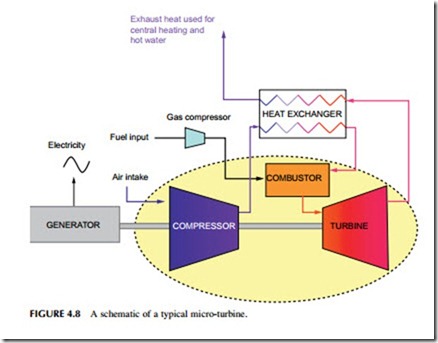MICRO-TURBINES
Micro-turbines are tiny gas turbines that can generate both electricity and heat. They vary in electrical output from around 25 kW to 250 kW. Units of between 250 kW and 500 kW are sometimes called mini-turbines. The two types are designed to be used in large domestic or small commercial environments where they can provide both forms of energy. As such, they are usually designated as distributed generators since they supply their power at the distribution level of the grid.
Depending on the source, micro-turbines are described as having evolved from turbochargers in automotive engines or auxiliary power units for aircraft. Whatever their origin, they are identical in their main components to conventional gas turbines with a compressor, a combustion chamber, and a power turbine (Figure 4.8). The main difference, apart from their size, is that a micro-turbine will only have one set of compressor blades and one set of turbine blades.
In most micro-turbines the generator is packaged with the turbine to provide a single unit that can be installed rapidly and with little preparation. As a con- sequence of their small size, micro-turbines and their generators operate at very high rotational speeds, typically between 40,000 rev/min and 120,000 rev/min. Generators rotating at these speeds cannot be connected directly to the grid. Instead they are connected through a solid-state interface that converts the high-frequency AC power produced by the generator to 50 Hz or 60 Hz as required to synchronize with the grid.
There are two general types of micro-turbine package available: simple and recuperated. The simple micro-turbines tend to be the more robust but their energy conversion efficiency is low at around 15%. However, this leaves a significant amount of waste heat in the turbine exhaust for supplying hot water in a cogeneration application. Recuperated micro-turbines use waste heat to heat compressed air between the compressor stage and the combustion chamber in exactly the way as industrial and aero-derivative gas turbines. Recuperation on a micro-turbine can increase overall conversion efficiency between 20% and 30%. With both types, waste heat capture for hot water can raise overall cogeneration efficiency to 85%.
Most micro-turbines are designed to burn natural gas. A packaged system will comprise the micro-turbine generator, a gas compressor to provide natural gas at the pressure required by the turbine combustion chamber, a solid-state grid interface, and, in many cases, a waste heat-recovery system. They have very low emissions and can be installed in domestic and commercial environments. Micro-turbines are more expensive than similarly sized reciprocating engines, but research is continuing with the aim of achieving much higher energy-to-electrical conversion efficiencies.
